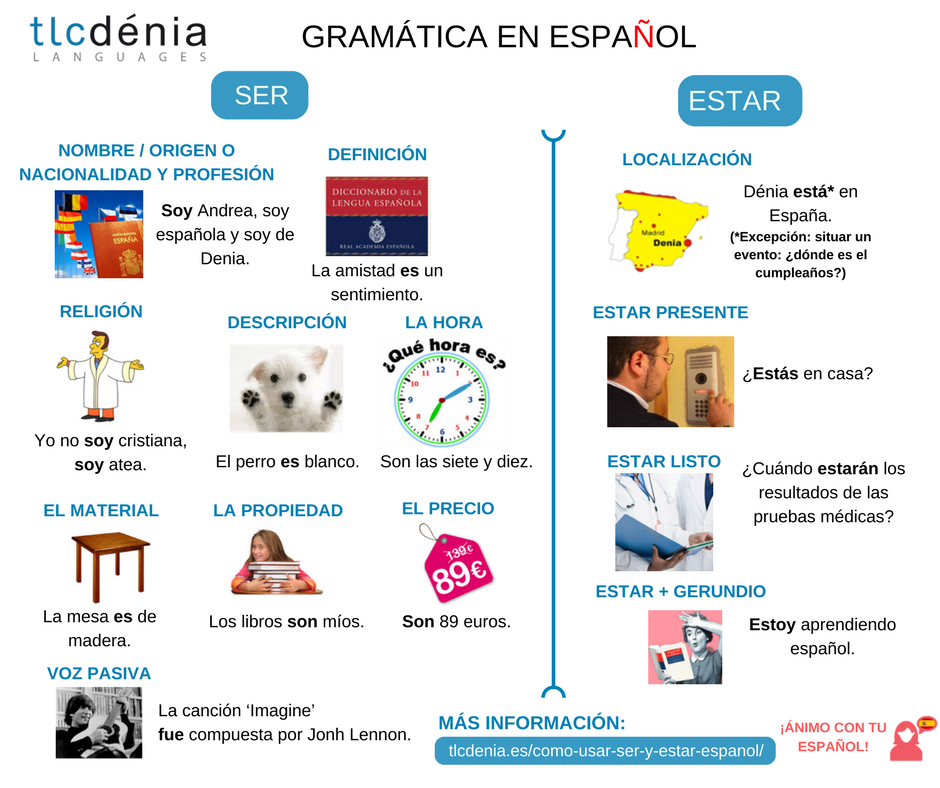
Ser vs. Estar What's the Difference? Forms Of Ser, Study Spanish, The Ing, We Are Best Friends
Review Time: if you're not sure how to conjugate these two important verbs (they're irregular), check out the verb conjugation tables for ser and estar.. Uses of Ser. Ser is used to talk about permanent or lasting attributes.If this general rule is too vague for you, think of the acronym DOCTOR, which stands for Descriptions, Occupations, Characteristics, Time, Origin, and Relationships.

Ser y estar lenguaje y otras luces
1. Ser Aburrido/a vs. Estar Aburrido/a. Soy aburrido /a means "I'm boring.". This means your entire essence is boring, and you are a boring person. You might want to say es aburrido/a (he/she/it is boring) when describing someone or something, but don't blame us if someone is insulted by this declaration.

SER Y ESTAR Diferencia Gramática Cognitiva ELE ArcheELE
When to Use Ser. Ser expresses the attributes of a person or thing. When you use ser, you're talking about characteristics that are a part of the essence of a person or thing: something unchangeable.. Let's have a look at all the situations when you choose ser as your translation for "to be.". 1. To identify a person or thing. Use ser to express qualities or characteristics of a person.

Spanish Classroom Activities, Learning Spanish For Kids, Spanish Lessons For Kids, Spanish
The biggest difference between ser and estar is: Ser is used to talk about what something is. It's used for permanent conditions or characteristics that are unlikely to change. Estar is used to talk about how something is. It's used for temporary states or qualities. We'll talk more about the different situations where you use ser and.

SER O ESTAR Comics, Character, Fictional characters
Present Tense of "Ser," "Estar," and "Tener". Ser ( to be ), estar ( to be ), and tener ( to have ), three of the most frequently used verbs in Spanish, are all irregular in the present tense. The present tense conjugations for the irregular verbs ser, estar, and tener are given below, along with some examples.

Ser o estar
Ser vs Estar: A Mountain of Examples. Ultimately, the best way to understand the difference between Ser and Estar is to see a TON of example situations and which verb to use. So we present to you just that: a mountain of detailed examples. Situation 1: Talking about a person. SER María is a happy person. María es una persona muy alegre.

Ser Estar / There are two verbs that mean to be in spanish, ser ultimately, the best way to
Introducción. Los verbos ser y estar son el mismo verbo en otros idiomas, pero en español tienen significados distintos. A continuación te damos algunas pistas para que aprendas a diferenciarlos de forma fácil y definitiva. En la sección de ejercicios puedes poner a prueba tus conocimientos.

Ejercicios de ser estar ejercicios de gramática Recursos de enseñanza de español
Ser is used to refer to a fact or characteristic of a person or object. Estar is used to describe perceptions, opinions, conditions, and any fact or circumstance that may vary over time. However, a slightly simpler way to illustrate their differences is by describing them with "permanent" and "temporary" states.

Die Benutzung von „ser“ und „estar“ in Spanisch TLCdénia
In a nutshell, the difference between ser and estar is that the first refers to permanent or lasting traits, while the latter refers to temporary conditions. Ser is used to: Identify people or things. Say the date and time. Describe people or things. Refer to the place of an event. Express origin or nationality.

When to use Ser and Estar verbs in Spanish, verb to be YouTube
Rob Ashby. The Spanish Obsessive. Few verbs have attracted as much attention and hours of study as the two "copular" verbs in Spanish: Ser and Estar. To an English native speaker, it seems bizarre to have two verbs which both mean "to be", and distinguishing between them and their uses can be a major challenge in studying Spanish.

Ser Estar / There are two verbs that mean to be in spanish, ser ultimately, the best way to
The English verb be has two translations in Spanish grammar: ser and estar. Ser is used for qualities and characteristics and in connection with adverbs of time. Estar describes temporary conditions, location, the present progressive. Learn the difference between ser and estar with Lingolia's online grammar rules and free exercises. Our lists help you learn which words and expressions are.

Diferencia entre ser y estar, bien y bueno. Español
Estar - Use 5 - Progressive tense. This use of estar forms a new Spanish tense, and is used to talk about what is happening continuously in any given moment. To form this tense you need to combine the verb estar with the Spanish gerundio, which is the Spanish equivalent of 'walking', 'singing', 'running', or 'talking'.

Common mistakes in Spanish TLCdenia Spanish school
It's easy to make mistakes when choosing between ser and estar. Here are some common errors to avoid. 1. Using estar, instead of ser, when describing occupations. In Spanish, we don't say La chica está un estudiante. We always use the verb ser when describing occupations.

¿Ser o estar? Interactive worksheet
Estar. Simply put, ser is used to talk about permanent states, while estar is used to talk about temporary conditions. In English, you would use the verb "to be" for both, but in Spanish they have somewhat different meanings. Another way to explain their difference is that ser talks about what something is and estar talks about how.

Ser y estar A vueltas con E/LE
Complete the gaps with the correct form of ser or estar in the present tense. Esa peluquería nueva en el barrio. [That salon is new to the neighbourhood.]|how something is → ser |3rd person singular: es. Nosotros en el cine. [We are at the cinema.]|current location → estar |1st person plural: estamos. Esas joyas de mi abuela.

Infografias Espanol
Use Ser for Permanence and Estar for Transience. This first tip is the guiding rule for figuring out when to use ser and estar.As you may already know, the main difference between ser and estar is that ser refers to more permanent traits of someone or something, while estar refers to transient conditions.Check out the difference in the following two examples: